Depending on what kind of neighborhood you live in, simply stepping outside might put your pet within just a few feet of a toxic plant or two. There are a wide variety of plants that are toxic to dogs and cats here in Holmdel, NJ, and many can be harmful to humans, too.
One plant in particular has become a growing concern for us as spring carries on and fills our yards and homes with lush flora. Pokeweed, once thought to be limited to the southern part of our state, has begun spreading throughout the region, and we want you and your pet to be kept safe from this pesky weed!

What is Pokeweed?
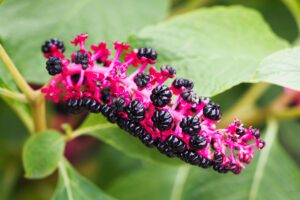
Pokeweed is a perennial flowering weed officially known as Phytolacca Americana. It can be found in open fields and parks, along fences and in grassy clearings. Pokeweed is a striking plant with a bright reddish stem, yellow-green leaves, and clusters of dark purple berries. It’s hard to miss once you know what it looks like.
Every part of the pokeweed plant is toxic to dogs and cats. It contains saponins and oxalates that can irritate the gastrointestinal tract and cause excessive salivation, vomiting, diarrhea, loss of appetite, tremors, and a drop in blood pressure. In a worst-case scenario, ingesting pokeweed can be deadly for your pet.
The berries are one part of the plant that may not cause illness if ingested, but it’s best to keep your dog or cat away from pokeweed altogether if possible! If you see any pokeweed growing in or near your yard, remove it immediately.
Other Plants that are Toxic to Dogs in Holmdel, NJ
Pokeweed is just one among many plants that are toxic to your pet. Below are several other notorious troublemakers you’ll need to look out for:
Poison Ivy
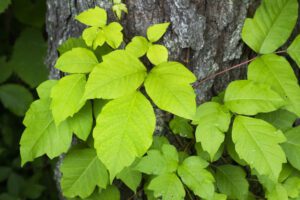
Poison ivy is one of the most common toxic plants around, and is distinguished by its three large, pointed leaves. Forest preserves are hotbeds for poison ivy, and one step off the path is all it takes to run into this plant. The leaves of a poison ivy plant contain urushiol oil and when this oil comes into contact with your pet’s skin (or yours), it will cause a rash to develop.
An important note about urushiol oil is that it can rub off on gloves, shoes, garden shears, and other surfaces. If you or your pet come into contact with a surface containing urushiol oil, your skin or your pet’s can still develop a painful rash.
Our also strongly advise against burning any toxic plants you rip out of the ground, as the smoke from these plants can also cause a skin rash and even irritate the eyes and throat.
Poison Oak
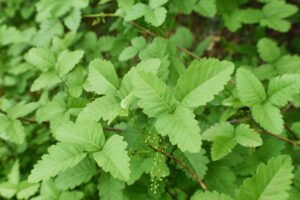
Poison oak is also notable for its three individual leaves, though these more closely resemble the leaves of an oak tree. Like poison ivy, poison oak contains toxic oils that can cause skin rashes on your pet.
Poison Sumac
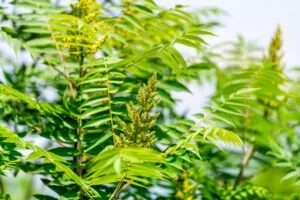
The leaves, stem, fruit, roots, and even sap of the poison sumac plant all contain urushiol oils, just like poison ivy and poison oak. Poison sumac has 9-17 pointed leaves growing on each stem, so it lacks the three-leaf appearance that poison ivy and poison oak are known for.
Poison Hemlock
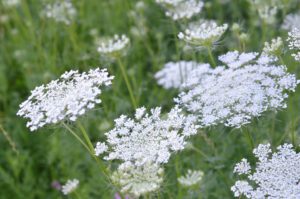
Poison hemlock is one of the most dangerous toxic plants in New Jersey for animals and humans alike. One of the things that makes this plant dangerous is its close resemblance to the harmless Queen Anne’s lace and fennel plants. Poison hemlock contains toxins known as coniine that can cause paralysis and even death if treatment is not administered quickly.
Monkshood
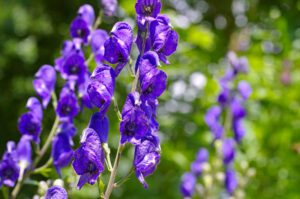
Monkshood has striking hood-shaped flowers that are lovely to look at, but the plant itself contains harmful toxins that can affect the nervous system. Symptoms of toxicity may include nausea and weakness, and lead to respiratory failure or even death without timely medical attention.
How to Protect Your Pet from Toxic Plants
The key to protecting your pet from toxic plants is to be aware of what’s growing in and around your yard, and anywhere else your dog happens to be. Take some time to look up common toxic plants in the Holmdel, NJ area and get familiar with their appearance so you can easily spot them while you’re out on walks.
Keep a close eye on your pet and make sure they’re not sniffing around any suspicious looking plants. It might seem hard to believe, but even the carcasses of dead field mice could contain remnants of toxic plants, which could then get ingested by your dog or cat!
We have been seeing many cases of intense gastrointestinal issues in dogs lately, and many of these cases are related to ingesting or coming into contact with toxic flora. If you have any questions or concerns about toxic plants and your pet’s safety, please get in touch with Bayshore Veterinary Hospital by calling (732) 671-3110!
We’ll be happy to answer your questions and point you to additional resources on the topic of plant toxicity and safety measures you can take.
